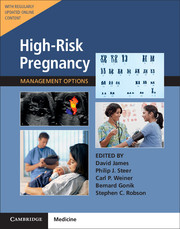Book contents
- Frontmatter
- Contents
- List of Contributors
- Preface
- Section 1 Prepregnancy Problems
- Section 2 Early Prenatal Problems
- Section 3 Late Prenatal – Fetal Problems
- Section 4 Problems Associated with Infection
- Section 5 Late Pregnancy – Maternal Problems
- Section 6 Late Prenatal – Obstetric Problems
- Section 7 Postnatal Problems
- Section 8 Normal Values
- 74 Normal Values in Pregnancy
- Index
74 - Normal Values in Pregnancy
from Section 8 - Normal Values
- Frontmatter
- Contents
- List of Contributors
- Preface
- Section 1 Prepregnancy Problems
- Section 2 Early Prenatal Problems
- Section 3 Late Prenatal – Fetal Problems
- Section 4 Problems Associated with Infection
- Section 5 Late Pregnancy – Maternal Problems
- Section 6 Late Prenatal – Obstetric Problems
- Section 7 Postnatal Problems
- Section 8 Normal Values
- 74 Normal Values in Pregnancy
- Index
Summary
Introduction
What is a “Normal” Value?
“Normal” has different meanings. In the context of physical or laboratory measurements, “normal” may mean “average,” “disease-free,” or “within a given statistical range.” However, it is important to know the characteristics of the population yielding “normal” values before deciding whether these values provide an appropriate reference range with which to compare an individual test result. Many laboratories now print reference ranges on their reports and highlight test values that fall outside these values as “abnormal.” When the test subject is a pregnant woman, a fetus, or a newborn, and the reference population is composed predominantly of middleaged men, then comparisons are patently inappropriate. It is important to understand how the physiologic changes of pregnancy affect the results of various tests and measurements before deciding whether an out-ofrange result is actually abnormal.
Changes in Pregnancy
Pregnancy results in profound changes in maternal physiology and metabolism, orchestrated by hormonal changes. Thus, physical and laboratory measurements may be very different in the pregnant state compared with the nonpregnant state and may change as pregnancy advances. Similarly, physical, biochemical, hormonal, and hematologic measurements of the fetus change markedly as the fetus increases in size and maturity. Thanks to ultrasound techniques, the fetus, formerly hidden within the uterus, is now accessible. Fetal structures can be measured, fetal behavior observed, and blood velocities measured with Doppler ultrasound. Ultrasound-guided needle placement can be used to access fetal blood or urine, amniotic fluid, and placental tissues.
Statistical Terms
The terms used to define normal values depend on the distribution characteristics of data points. The entire range of values encountered in a healthy population may be quoted as reference points, or distribution may be described by terms that express central tendency and scatter. When data are distributed symmetrically around a central value (i.e., normal distribution), mean, standard deviation (SD), and standard error of the mean (SEM) are the appropriate statistics. From these, ranking values, or percentiles, may be calculated (e.g., 5th and 95th percentiles, which encompass the central 90% of data points, with 5% on either side of them). When the data distribution is skewed, median and percentiles should be used. When the data distribution is exponential, median and multiples of the median (MoM) can be used rather than percentiles. Specialized texts provide a more detailed critical appraisal of the statistical analyses used in these studies.
- Type
- Chapter
- Information
- High-Risk Pregnancy: Management OptionsFive-Year Institutional Subscription with Online Updates, pp. 2087 - 2194Publisher: Cambridge University PressFirst published in: 2017



